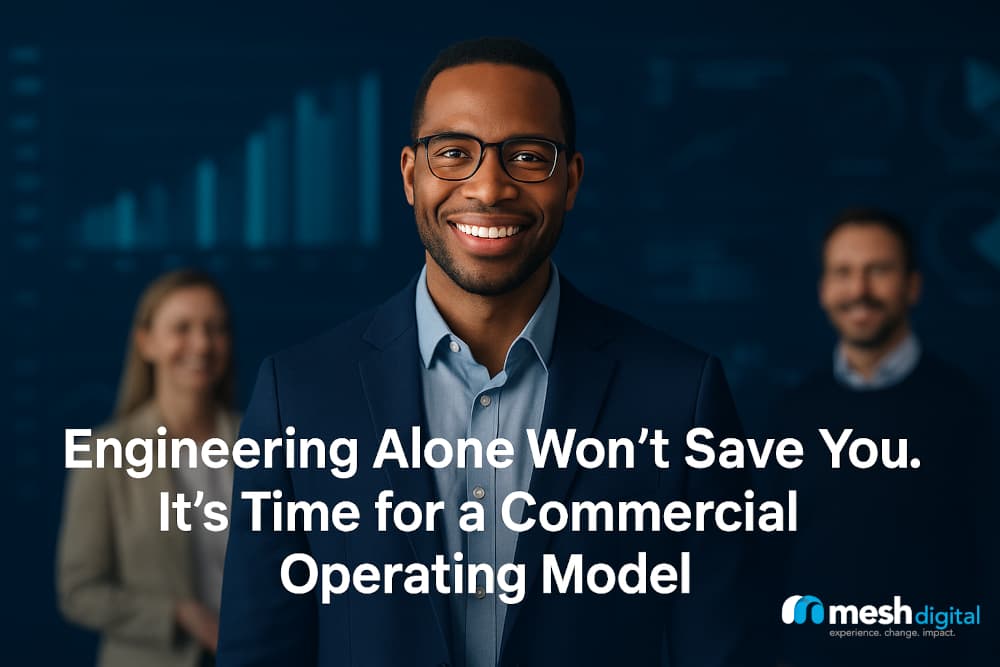Engineering Alone Won’t Save You. It’s Time for a Commercial Operating Model.
Most transformations over-index on activity, not value. Strategy-in-Motion PODs™ link board intent to engineering with one backlog, capital rules, and live telemetry—delivering predictable costs, faster cycle times, and AI that ships to production. If it doesn’t move P&L/risk, it’s tech debt.

Let’s be blunt: most “transformations” are over-scoped, under-governed, and optimized for ceremony over value. Roadmaps multiply, backlogs compete, and budgets get locked before learning. Engineering ships features while the enterprise still waits for outcomes. If your org feels like it’s sprinting in place, you’re not alone, and you’re not imagining it.
Strategy-in-Motion PODs™ is our antidote. It’s an execution-first operating model that ties board-level intent to engineering reality, linking strategy, delivery, and capital with a single path to value. The result: predictable costs, fewer hand-offs, faster cycle times, and measurable business impact.
The CIO/CTO Reality: Four Friction Points (and How Strategy-in-Motion PODs™ Remove Them)
1) “Two truths” problem - strategy vs. delivery.
You present a clear strategy in Q1; by Q2, portfolios drift and priorities fork across channels, data, and platform teams.
POD answer: One integrated mandate. Each POD owns a slice of enterprise strategy and the code path to deliver it, no split between slideware and shipware. The team contains strategy leaders, product/engineering, data/AI, and finance so the same people who make the bet (by proxy) also operationalize it.
2) Funding theater—capital by influence, not evidence.
Large projects survive on narrative momentum; smaller, higher-yield bets starve.
POD answer: Capital choreography. A transparent scoring rubric allocates dollars to the highest value-per-risk work; de-prioritized items are explicitly named. Finance sits inside the POD to preserve predictability and to stop re-justifying budgets every sprint. We're not talking about enterprise Agile funding model shifts, instead think micro-financing small bets.
3) Agility that breaks the forecast.
Teams pivot; forecasts implode; confidence erodes.
POD answer: Modular agility. Capacity scales by POD module (not by reorg). You can pivot without detonating the plan because the unit of change is the POD, not the whole portfolio.
4) AI pilots that never cross the enterprise chasm.
Models exist, but adoption stalls on data quality, governance, and change.
POD answer: AI is part of Definition of Done. Data contracts, model lifecycle, and guardrails (quality, ethics, security) are integrated into the same backlog as features, not bolted on afterward.
What Commercially-Minded Technology Leaders Actually Want
- Business-credible roadmaps. One backlog per POD tied to value hypotheses, not feature counts.
- Predictable cost of change. Portfolio knobs you can turn without renegotiating the world.
- Evidence-based decisions. Telemetry that connects product, platform, and data work to revenue, margin, cost-to-serve, risk, and satisfaction.
- Fewer meetings, more movement. Cross-functional decision rights defined once and exercised weekly, not re-litigated monthly.
Strategy-in-Motion PODs™ are built for exactly this. High-performing strategy organizations excel when mandate and governance are crystal-clear, when collaboration with the business is real (not performative), and when value-oriented skills (finance, M&A, capital allocation) sit next to strategy and delivery.
Inside a Technology-Led Strategy-in-Motion PODs™
Strategy Anchor
- Enterprise OKRs + economic model (e.g., cost-to-serve reduction, recurring revenue mix).
- Customer / Patient and operator journeys define “value moments” for telemetry.
Product & Engineering Spine
- One backlog blending product, platform, data/AI, and enabling tech.
- Release trains tied to value milestones (e.g., claim auto-adjudication rate) not only story points.
Data/AI Core
- Data contracts and SLOs; governance gates embedded in CI/CD.
- Model monitoring (drift, bias, safety) managed as code; rollback plans rehearsed.
Capital & Telemetry Layer
- Portfolio scoring rubric; rolling forecast tied to POD velocity and realized value.
- Near Time / Live dashboards: revenue lift, margin impact, unit economics, risk deltas, adoption.
Change & Adoption Track
- Frontline enablement and incentives designed in; instrumentation proves behavior change, not just feature release.
The First 90 Days: What Changes (and What Stops)
- Unify the backlogs. Collapse product, platform, data, and “transformation” queues into a single value-ranked backlog per POD. No metric → no epic.
- Wire the value loop. Instrument five measures per epic: revenue, margin, cost-to-serve, risk, and adoption. Ship dashboards before you ship refactors.
- Codify capital rules. Publish how bets are scored, what’s paused, and why. End funding theater.
- Institutionalize guardrails. Make security, compliance, and AI governance automatic via pipelines—speed andsafety.
- Ritualize decisions. Weekly signal → monthly portfolio decisions. Steering is about deltas and trade-offs, not slide production.
The Provocation: If It Doesn’t Move the P&L or Risk Curve, It’s Tech Debt in Disguise
Modernization, platform work, and AI are means, not ends. If a quarter passes without visible movement in unit cost, cycle time, churn, ARPU, loss ratio, or risk posture, then you shipped activity, not value. PODs force the economic conversation every sprint and give you the mechanism to reallocate capacity without chaos.
What Boards and CEOs Will Notice (Because You’ll Show Them)
- Predictable costs. Modular POD capacity priced transparently; pivot without repricing the entire program.
- Shorter idea-to-impact. Fewer hand-offs, clearer decision rights, measurable cycle-time compression.
- De-politicized portfolio. Funding moves with evidence; priorities and trade-offs are auditable.
- Production-grade AI. Controlled rollouts with observable lift and managed risk.
Why This Works (and Why “More Talent” Isn’t the Answer)
Data from large cross-company benchmarks shows the differentiators of top strategy organizations are mandate clarity, governance, and collaboration with the business, not bigger teams or better presentation skills. Teams that try to juggle multiple mandates without clarity are materially less likely to be top performers; those that master collaboration and keep a value-oriented lens outperform. Strategy-in-Motion PODs™ operationalize those lessons directly inside the technology portfolio.
Closing Thought
You don’t need another advisory, framework, or another platform promise. You need an operating model that turns commercial intent into shipped outcomes reliably, transparently, and at a predictable cost. Strategy-in-Motion PODs™ give CIOs and CTOs the levers to do exactly that: one path, one backlog, one accountable motion.
Because in the end, the enterprise doesn’t reward throughput, it rewards value.
